Abstract
From the cohort taking part in the Atherosclerosis Risk in Communities (ARIC) study, a multicenter investigation of atherosclerosis and its sequelae in women and men ages 45-64 years, a sample of 145 subjects with significant carotid artery atherosclerosis but without clinically recognized coronary heart disease was identified along with 224 group-matched control subjects. The aim of this paper is to measure the association of the apolipoprotein (apo) E polymorphism with the prevalence of significant carotid artery atherosclerotic disease (CAAD) after considering the contribution of established risk factor variables. The first model used a stepwise selection procedure to define a group of significant physical and lifestyle characteristics and a group of significant plasma lipid, lipoprotein, and apolipoprotein variables that were predictive of CAAD status in this sample. Those variables selected included age (years), body mass index (BMI; kg/m2), consumption of cigarettes (CigYears; number of cigarettes/d x the number of smoking years), hypertension status, high-density lipoprotein (HDL)-cholesterol (mg/dl), total cholesterol (mg/dl), and Lp[a] (micrograms/ml). The second model was built by forcing into the equation an a priori set of demographic, anthropometric, and lipoprotein variables, which were age, BMI, CigYears, hypertensive status, LDL-cholesterol, and HDL-cholesterol. In both models, the apo E genotype epsilon 2/3 was related to CAAD status. For both models, the estimated odds ratio of being a CAAD case associated with the apo E genotype epsilon 2/3 was > 2:1. The mechanism of the observed association between the epsilon 2/3 genotype and carotid atherosclerosis is unknown, but it is likely due to the known effects of the E2 isoform in causing delayed clearance of triglyceride-rich lipoproteins.
Full text
PDF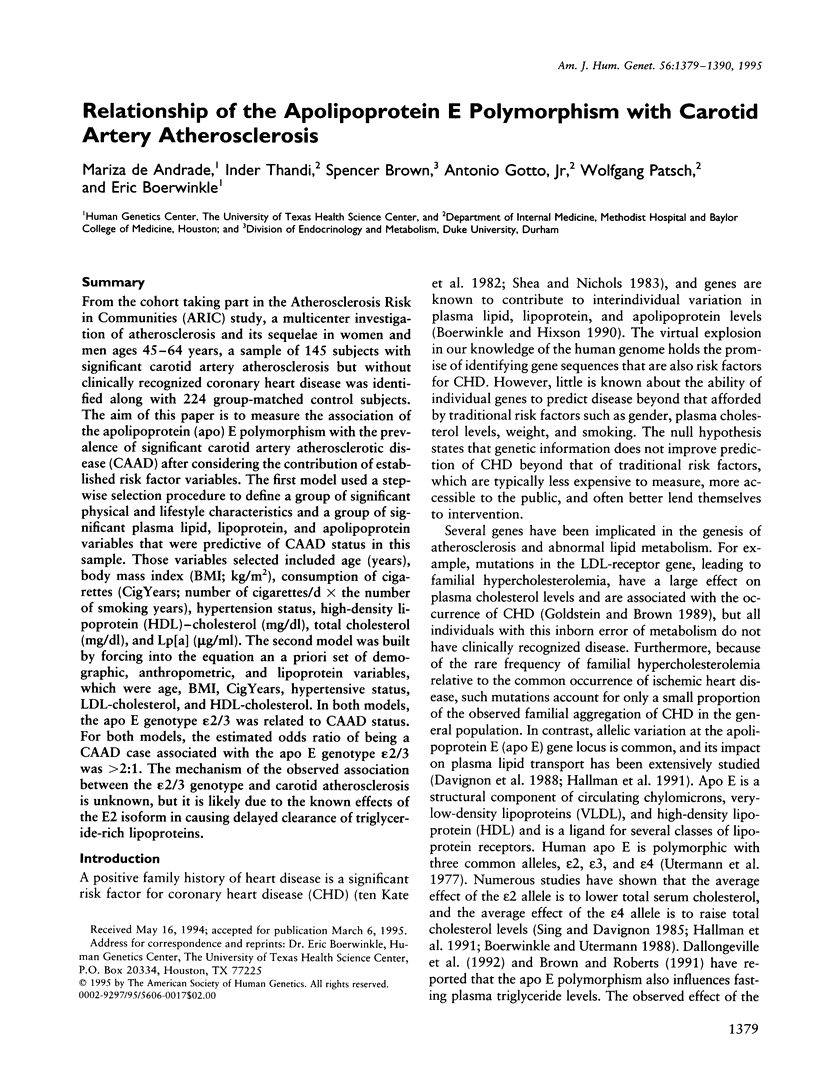
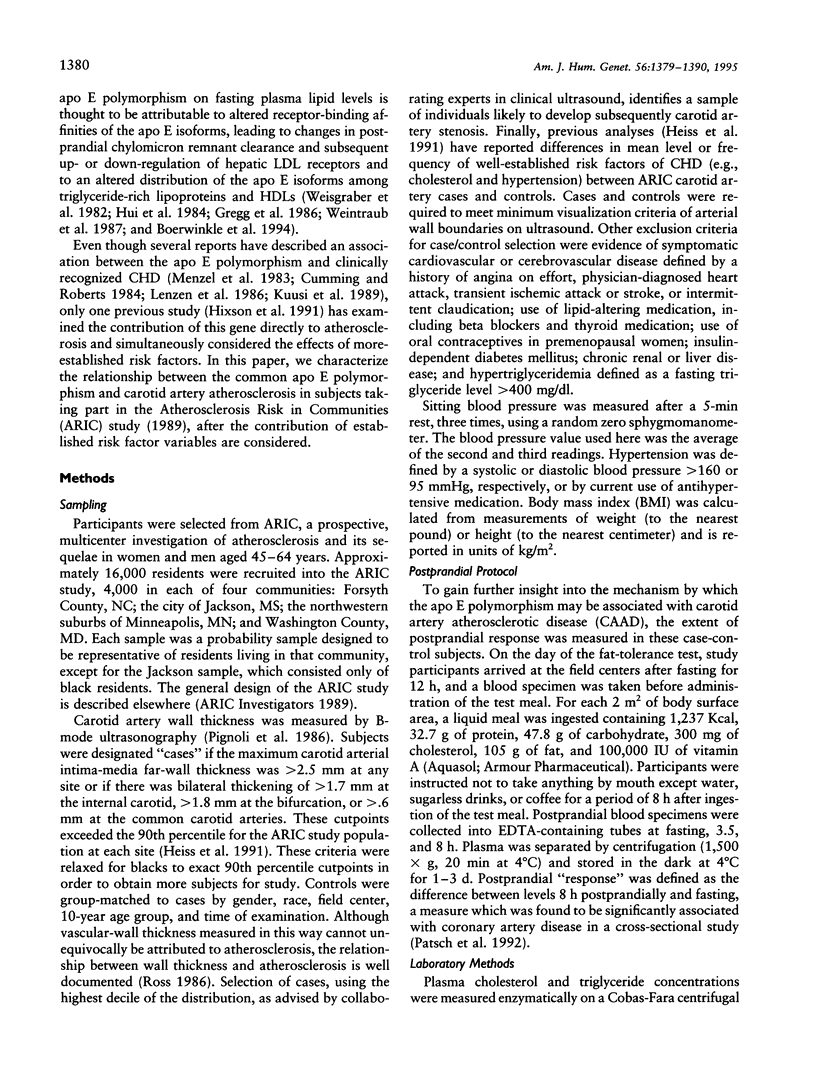
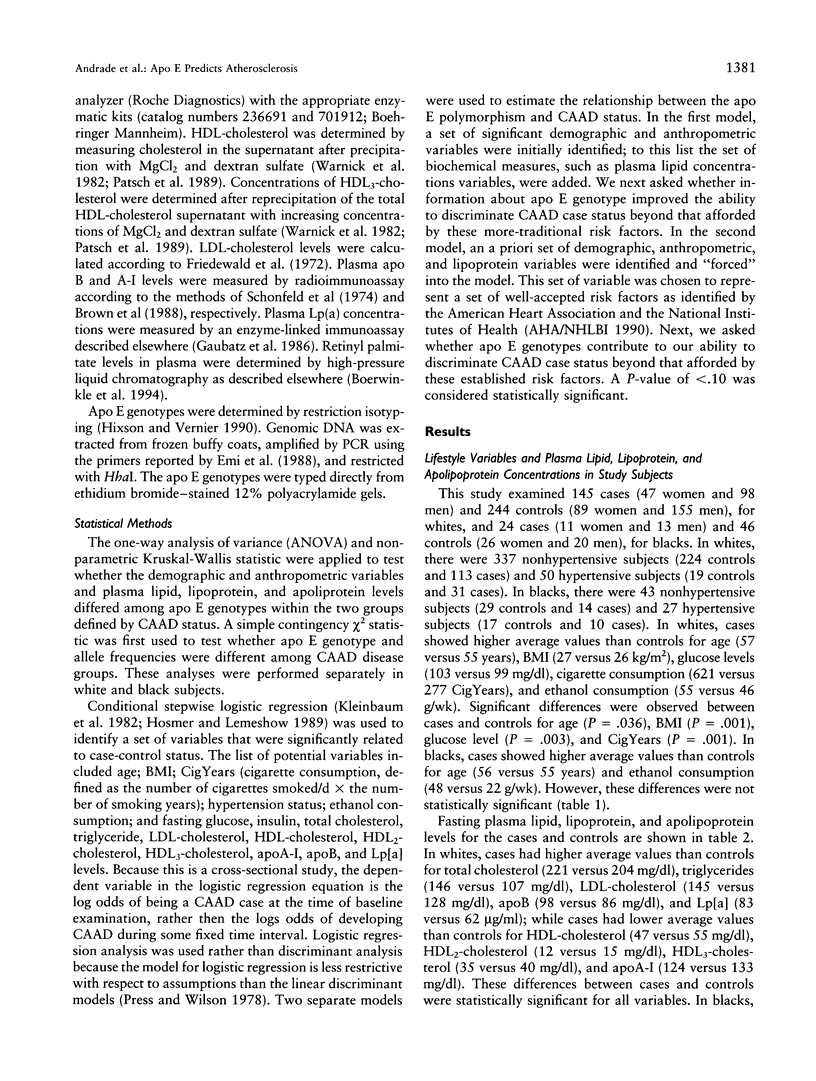
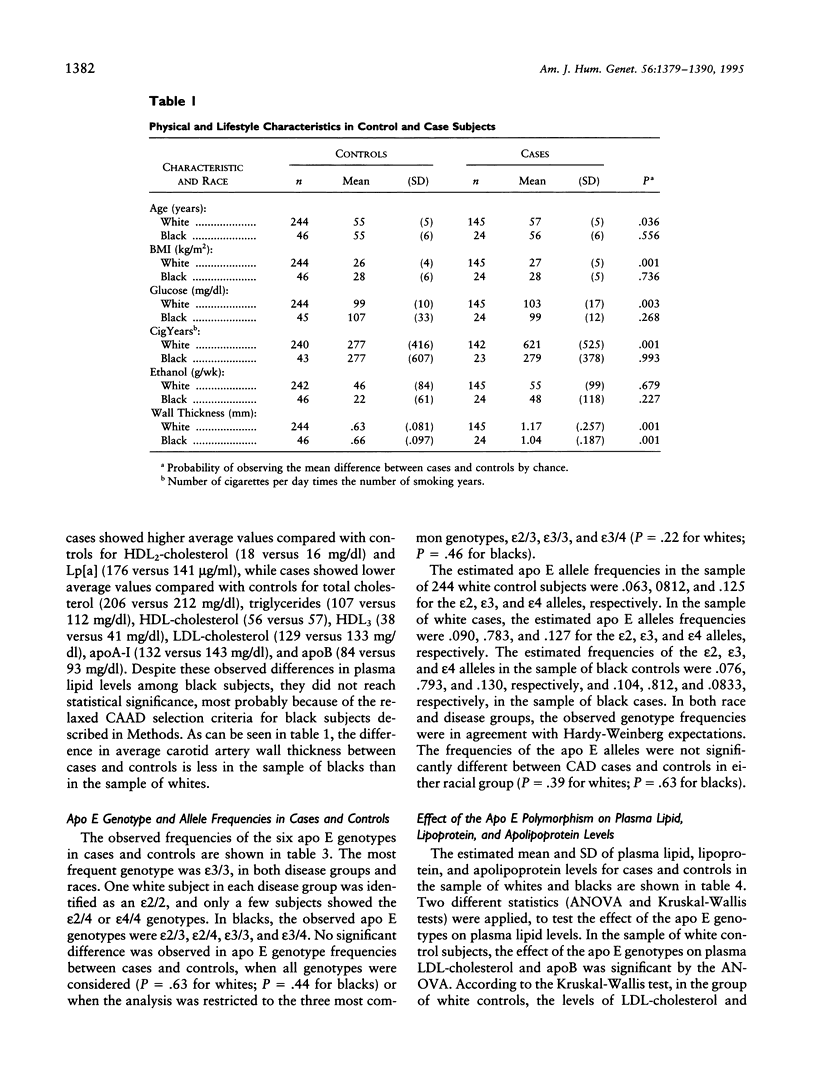
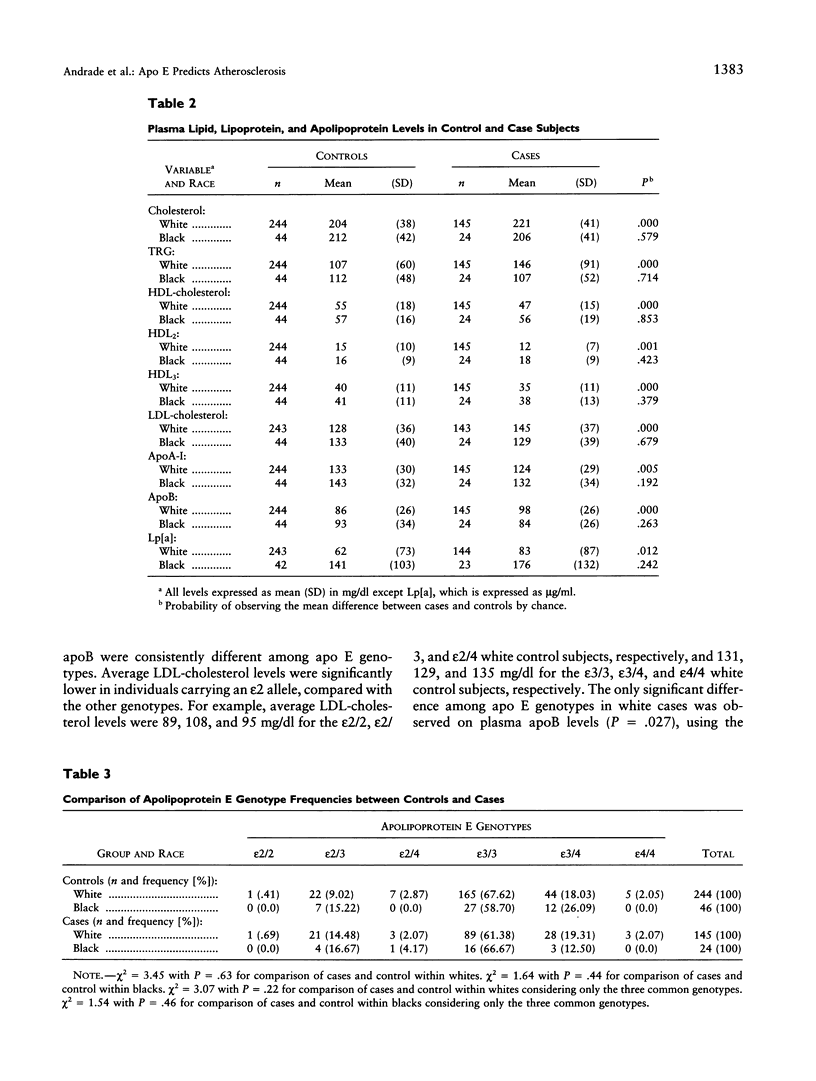
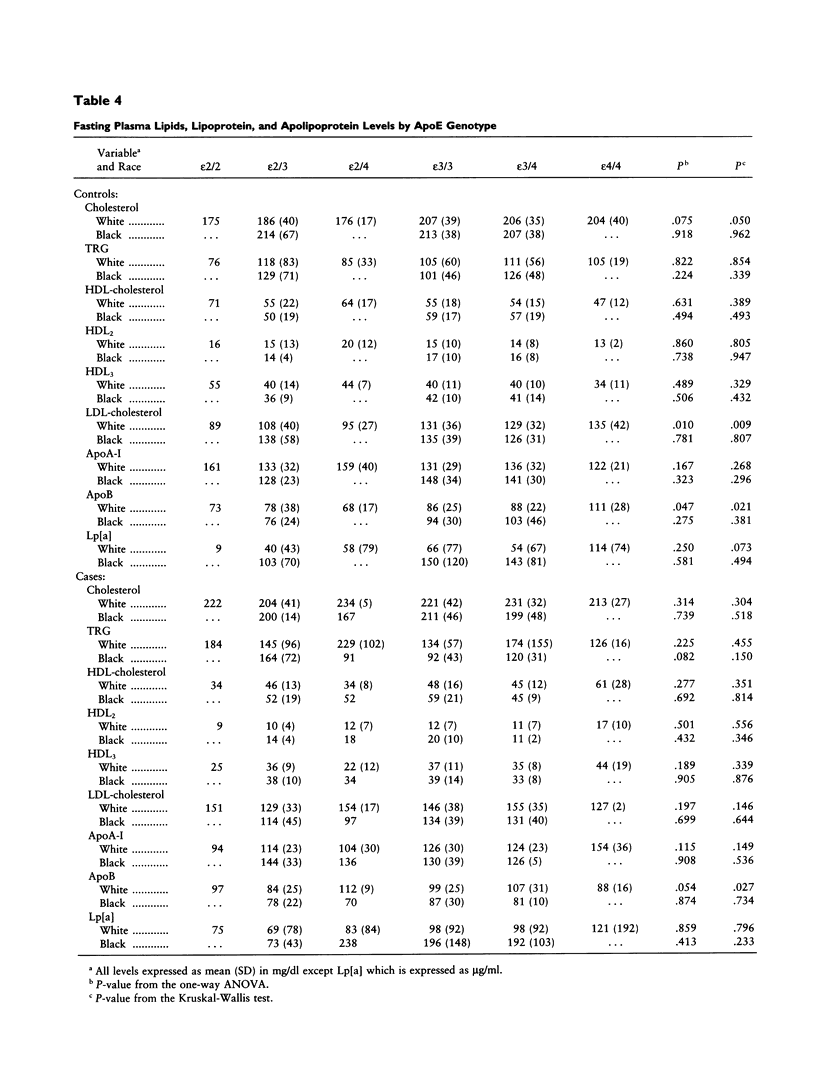
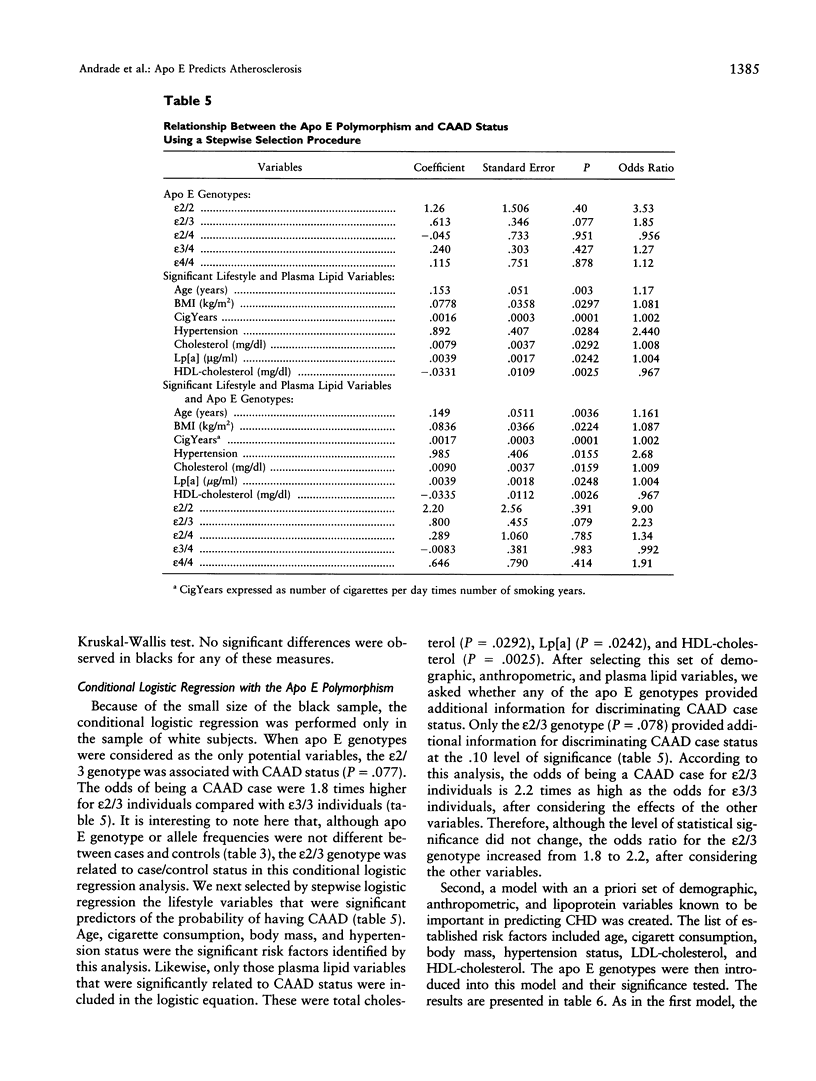
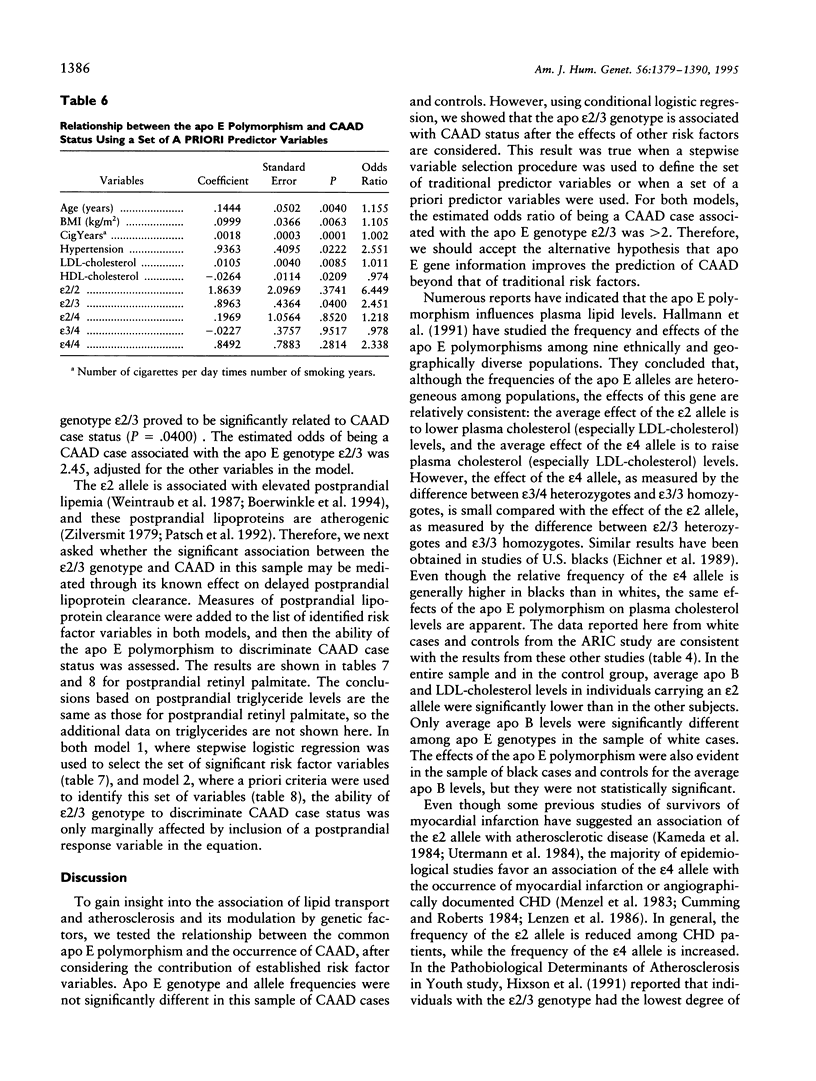

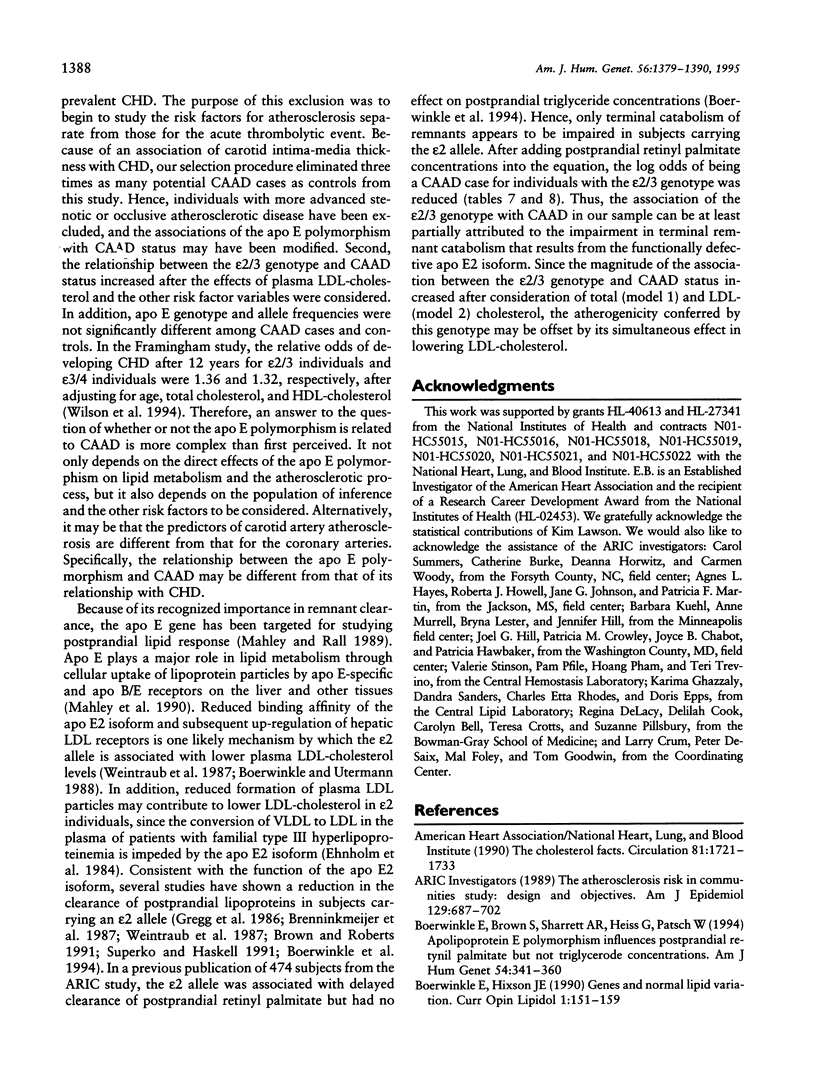

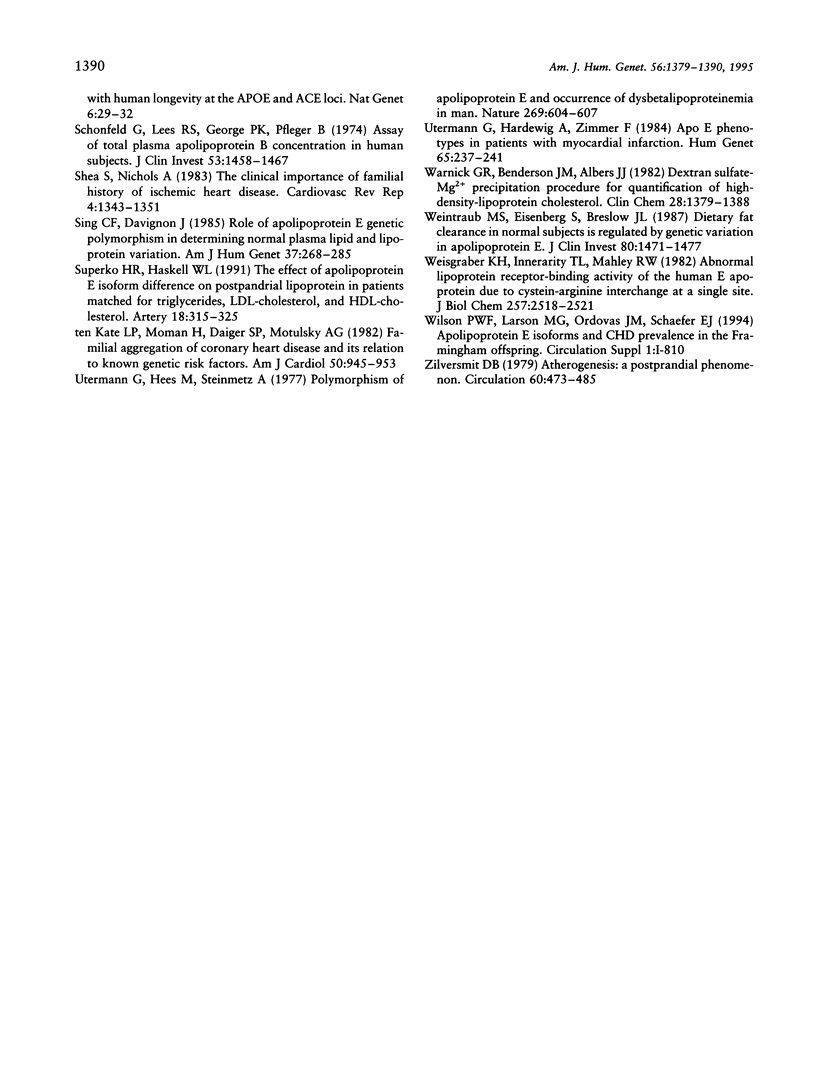
Selected References
These references are in PubMed. This may not be the complete list of references from this article.
- Boerwinkle E., Brown S., Sharrett A. R., Heiss G., Patsch W. Apolipoprotein E polymorphism influences postprandial retinyl palmitate but not triglyceride concentrations. Am J Hum Genet. 1994 Feb;54(2):341–360. [PMC free article] [PubMed] [Google Scholar]
- Boerwinkle E., Utermann G. Simultaneous effects of the apolipoprotein E polymorphism on apolipoprotein E, apolipoprotein B, and cholesterol metabolism. Am J Hum Genet. 1988 Jan;42(1):104–112. [PMC free article] [PubMed] [Google Scholar]
- Brenninkmeijer B. J., Stuyt P. M., Demacker P. N., Stalenhoef A. F., van 't Laar A. Catabolism of chylomicron remnants in normolipidemic subjects in relation to the apoprotein E phenotype. J Lipid Res. 1987 Apr;28(4):361–370. [PubMed] [Google Scholar]
- Brown A. J., Roberts D. C. The effect of fasting triacylglyceride concentration and apolipoprotein E polymorphism on postprandial lipemia. Arterioscler Thromb. 1991 Nov-Dec;11(6):1737–1744. doi: 10.1161/01.atv.11.6.1737. [DOI] [PubMed] [Google Scholar]
- Brown S. A., Rhodes C. E., Dunn K., Gotto A. M., Jr, Patsch W. Effect of blood collection and processing on radioimmunoassay results for apolipoprotein A-I in plasma. Clin Chem. 1988 May;34(5):920–924. [PubMed] [Google Scholar]
- Cumming A. M., Robertson F. W. Polymorphism at the apoprotein-E locus in relation to risk of coronary disease. Clin Genet. 1984 Apr;25(4):310–313. doi: 10.1111/j.1399-0004.1984.tb01995.x. [DOI] [PubMed] [Google Scholar]
- Dallongeville J., Lussier-Cacan S., Davignon J. Modulation of plasma triglyceride levels by apoE phenotype: a meta-analysis. J Lipid Res. 1992 Apr;33(4):447–454. [PubMed] [Google Scholar]
- Davignon J., Gregg R. E., Sing C. F. Apolipoprotein E polymorphism and atherosclerosis. Arteriosclerosis. 1988 Jan-Feb;8(1):1–21. doi: 10.1161/01.atv.8.1.1. [DOI] [PubMed] [Google Scholar]
- Ehnholm C., Mahley R. W., Chappell D. A., Weisgraber K. H., Ludwig E., Witztum J. L. Role of apolipoprotein E in the lipolytic conversion of beta-very low density lipoproteins to low density lipoproteins in type III hyperlipoproteinemia. Proc Natl Acad Sci U S A. 1984 Sep;81(17):5566–5570. doi: 10.1073/pnas.81.17.5566. [DOI] [PMC free article] [PubMed] [Google Scholar]
- Eichner J. E., Kuller L. H., Ferrell R. E., Kamboh M. I. Phenotypic effects of apolipoprotein structural variation on lipid profiles. IV. Apolipoprotein polymorphisms in a small group of black women from the healthy women study. Genet Epidemiol. 1989;6(6):681–689. doi: 10.1002/gepi.1370060605. [DOI] [PubMed] [Google Scholar]
- Emi M., Wu L. L., Robertson M. A., Myers R. L., Hegele R. A., Williams R. R., White R., Lalouel J. M. Genotyping and sequence analysis of apolipoprotein E isoforms. Genomics. 1988 Nov;3(4):373–379. doi: 10.1016/0888-7543(88)90130-9. [DOI] [PubMed] [Google Scholar]
- Friedewald W. T., Levy R. I., Fredrickson D. S. Estimation of the concentration of low-density lipoprotein cholesterol in plasma, without use of the preparative ultracentrifuge. Clin Chem. 1972 Jun;18(6):499–502. [PubMed] [Google Scholar]
- Gaubatz J. W., Cushing G. L., Morrisett J. D. Quantitation, isolation, and characterization of human lipoprotein (a). Methods Enzymol. 1986;129:167–186. doi: 10.1016/0076-6879(86)29068-0. [DOI] [PubMed] [Google Scholar]
- Gregg R. E., Zech L. A., Schaefer E. J., Stark D., Wilson D., Brewer H. B., Jr Abnormal in vivo metabolism of apolipoprotein E4 in humans. J Clin Invest. 1986 Sep;78(3):815–821. doi: 10.1172/JCI112645. [DOI] [PMC free article] [PubMed] [Google Scholar]
- Hallman D. M., Boerwinkle E., Saha N., Sandholzer C., Menzel H. J., Csázár A., Utermann G. The apolipoprotein E polymorphism: a comparison of allele frequencies and effects in nine populations. Am J Hum Genet. 1991 Aug;49(2):338–349. [PMC free article] [PubMed] [Google Scholar]
- Heiss G., Sharrett A. R., Barnes R., Chambless L. E., Szklo M., Alzola C. Carotid atherosclerosis measured by B-mode ultrasound in populations: associations with cardiovascular risk factors in the ARIC study. Am J Epidemiol. 1991 Aug 1;134(3):250–256. doi: 10.1093/oxfordjournals.aje.a116078. [DOI] [PubMed] [Google Scholar]
- Hixson J. E. Apolipoprotein E polymorphisms affect atherosclerosis in young males. Pathobiological Determinants of Atherosclerosis in Youth (PDAY) Research Group. Arterioscler Thromb. 1991 Sep-Oct;11(5):1237–1244. doi: 10.1161/01.atv.11.5.1237. [DOI] [PubMed] [Google Scholar]
- Hixson J. E., Vernier D. T. Restriction isotyping of human apolipoprotein E by gene amplification and cleavage with HhaI. J Lipid Res. 1990 Mar;31(3):545–548. [PubMed] [Google Scholar]
- Kameda K., Matsuzawa Y., Kubo M., Ishikawa K., Maejima I., Yamamura T., Yamamoto A., Tarui S. Increased frequency of lipoprotein disorders similar to type III hyperlipoproteinemia in survivors of myocardial infarction in Japan. Atherosclerosis. 1984 May-Jun;51(2-3):241–249. doi: 10.1016/0021-9150(84)90171-0. [DOI] [PubMed] [Google Scholar]
- Kuusi T., Nieminen M. S., Ehnholm C., Yki-Järvinen H., Valle M., Nikkilä E. A., Taskinen M. R. Apoprotein E polymorphism and coronary artery disease. Increased prevalence of apolipoprotein E-4 in angiographically verified coronary patients. Arteriosclerosis. 1989 Mar-Apr;9(2):237–241. doi: 10.1161/01.atv.9.2.237. [DOI] [PubMed] [Google Scholar]
- Lenzen H. J., Assmann G., Buchwalsky R., Schulte H. Association of apolipoprotein E polymorphism, low-density lipoprotein cholesterol, and coronary artery disease. Clin Chem. 1986 May;32(5):778–781. [PubMed] [Google Scholar]
- Menzel H. J., Kladetzky R. G., Assmann G. Apolipoprotein E polymorphism and coronary artery disease. Arteriosclerosis. 1983 Jul-Aug;3(4):310–315. doi: 10.1161/01.atv.3.4.310. [DOI] [PubMed] [Google Scholar]
- Patsch J. R., Miesenböck G., Hopferwieser T., Mühlberger V., Knapp E., Dunn J. K., Gotto A. M., Jr, Patsch W. Relation of triglyceride metabolism and coronary artery disease. Studies in the postprandial state. Arterioscler Thromb. 1992 Nov;12(11):1336–1345. doi: 10.1161/01.atv.12.11.1336. [DOI] [PubMed] [Google Scholar]
- Patsch W., Brown S. A., Morrisett J. D., Gotto A. M., Jr, Patsch J. R. A dual-precipitation method evaluated for measurement of cholesterol in high-density lipoprotein subfractions HDL2 and HDL3 in human plasma. Clin Chem. 1989 Feb;35(2):265–270. [PubMed] [Google Scholar]
- Pignoli P., Tremoli E., Poli A., Oreste P., Paoletti R. Intimal plus medial thickness of the arterial wall: a direct measurement with ultrasound imaging. Circulation. 1986 Dec;74(6):1399–1406. doi: 10.1161/01.cir.74.6.1399. [DOI] [PubMed] [Google Scholar]
- Ross R. The pathogenesis of atherosclerosis--an update. N Engl J Med. 1986 Feb 20;314(8):488–500. doi: 10.1056/NEJM198602203140806. [DOI] [PubMed] [Google Scholar]
- Schonfeld G., Lees R. S., George P. K., Pfleger B. Assay of total plasma apolipoprotein B concentration in human subjects. J Clin Invest. 1974 May;53(5):1458–1467. doi: 10.1172/JCI107694. [DOI] [PMC free article] [PubMed] [Google Scholar]
- Sing C. F., Davignon J. Role of the apolipoprotein E polymorphism in determining normal plasma lipid and lipoprotein variation. Am J Hum Genet. 1985 Mar;37(2):268–285. [PMC free article] [PubMed] [Google Scholar]
- Superko H. R., Haskell W. L. The effect of apolipoprotein E isoform difference on postprandial lipoprotein in patients matched for triglycerides, LDL-cholesterol, and HDL-cholesterol. Artery. 1991;18(6):315–325. [PubMed] [Google Scholar]
- Utermann G., Hardewig A., Zimmer F. Apolipoprotein E phenotypes in patients with myocardial infarction. Hum Genet. 1984;65(3):237–241. doi: 10.1007/BF00286509. [DOI] [PubMed] [Google Scholar]
- Utermann G., Hees M., Steinmetz A. Polymorphism of apolipoprotein E and occurrence of dysbetalipoproteinaemia in man. Nature. 1977 Oct 13;269(5629):604–607. doi: 10.1038/269604a0. [DOI] [PubMed] [Google Scholar]
- Warnick G. R., Benderson J., Albers J. J. Dextran sulfate-Mg2+ precipitation procedure for quantitation of high-density-lipoprotein cholesterol. Clin Chem. 1982 Jun;28(6):1379–1388. [PubMed] [Google Scholar]
- Weisgraber K. H., Innerarity T. L., Mahley R. W. Abnormal lipoprotein receptor-binding activity of the human E apoprotein due to cysteine-arginine interchange at a single site. J Biol Chem. 1982 Mar 10;257(5):2518–2521. [PubMed] [Google Scholar]
- Zilversmit D. B. Atherogenesis: a postprandial phenomenon. Circulation. 1979 Sep;60(3):473–485. doi: 10.1161/01.cir.60.3.473. [DOI] [PubMed] [Google Scholar]
- ten Kate L. P., Boman H., Daiger S. P., Motulsky A. G. Familial aggregation of coronary heart disease and its relation to known genetic risk factors. Am J Cardiol. 1982 Nov;50(5):945–953. doi: 10.1016/0002-9149(82)90400-3. [DOI] [PubMed] [Google Scholar]


